NEET Exam > NEET Notes > Biology Class 11 > Mitochondria, Plastid, Ribosome & Cytoskeleton
Mitochondria, Plastid, Ribosome & Cytoskeleton | Biology Class 11 - NEET PDF Download
| Table of contents |

|
| Mitochondria |

|
| Plastids |

|
| Ribosomes |

|
| Cytoskeleton |

|
Mitochondria
- Mitochondria (sing.: mitochondrion), unless specifically stained, are not easily visible under the microscope.
- The number of mitochondria per cell is variable depending on the physiological activity of the cells.
- In terms of shape and size also, a considerable degree of variability is observed.
- Typically, it is sausage-shaped or cylindrical having a diameter of 0.2-1.0µm (average 0.5µm) and length 1.0-4.1µm.
- Each mitochondrion is a double membrane-bound structure with the outer membrane and the inner membrane dividing its lumen distinctly into two aqueous compartments, i.e., the outer compartment and the inner compartment.

- The inner compartment is filled with a dense homogeneous substance called the matrix.
- The outer membrane forms the continuous limiting boundary of the organelle.
- The inner membrane forms a number of infoldings called the cristae (sing.: crista) towards the matrix (Figure 8.7).
- The cristae increase the surface area.
- The two membranes have their own specific enzymes associated with the mitochondrial function.
- Mitochondria are the sites of aerobic respiration.
- They produce cellular energy in the form of ATP, hence they are called ‘power houses’ of the cell.
- The matrix also possesses a single circular DNA molecule, a few RNA molecules, ribosomes (70S) and the components required for the synthesis of proteins.
- The mitochondria divide by fission.
Plastids

- Plastids are found in all plant cells and in euglenoides. These are easily observed under the microscope as they are large. They bear some specific pigments, thus imparting specific colours to the plants.
- Based on the type of pigments, plastids can be classified into chloroplasts, chromoplasts, and leucoplasts.
- The chloroplasts contain chlorophyll and carotenoid pigments which are responsible for trapping light energy essential for photosynthesis.
- In the chromoplasts , fat-soluble carotenoid pigments like carotene, xanthophylls, and others are present. This gives the part of the plant a yellow, orange, or red colour.
- The leucoplasts are the colourless plastids of varied shapes and sizes with stored nutrients:
- Amyloplasts store carbohydrates (starch), e.g., potato;
- elaioplasts store oils and fats;
- aleuroplasts store proteins.
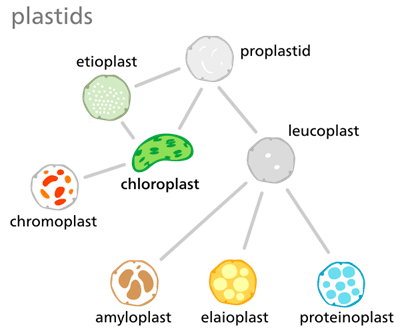
- The majority of the chloroplasts of the green plants are found in the mesophyll cells of the leaves. These are lens-shaped, oval, spherical, discoid, or even ribbon-like organelles having variable length (5-10µm) and width (2-4µm).
- Their number varies from 1 per cell of the Chlamydomonas, a green alga, to 20-40 per cell in the mesophyll.
- Like mitochondria, the chloroplasts are also double membrane bound. Of the two, the inner chloroplast membrane is relatively less permeable.
- The space limited by the inner membrane of the chloroplast is called the stroma. A number of organised flattened membranous sacs called the thylakoids are present in the stroma.
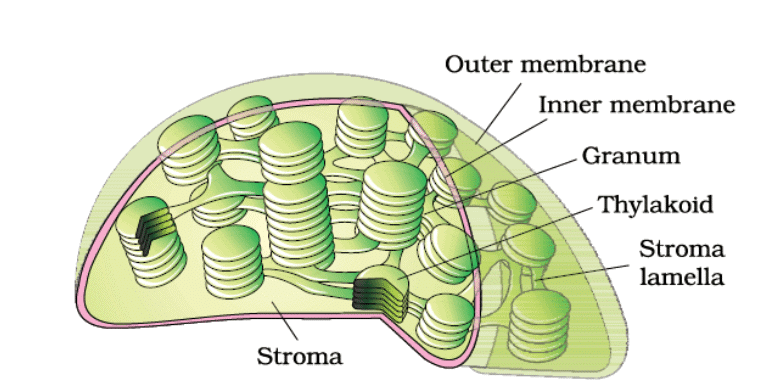 Chloroplast Sectional View
Chloroplast Sectional View
- Thylakoids are arranged in stacks like the piles of coins called grana (singular: granum) or the intergranal thylakoids. In addition, there are flat membranous tubules called the stroma lamellae connecting the thylakoids of the different grana.
- The membrane of the thylakoids encloses a space called a lumen. The stroma of the chloroplast contains enzymes required for the synthesis of carbohydrates and proteins.
- It also contains small, double-stranded circular DNA molecules and ribosomes. Chlorophyll pigments are present in the thylakoids. The ribosomes of the chloroplasts are smaller (70S) than the cytoplasmic ribosomes (80S).
Ribosomes
- Ribosomes are the granular structures first observed under the electron microscope as dense particles by George Palade (1953).
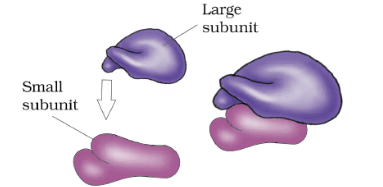
- They are composed of ribonucleic acid (RNA) and proteins and are not surrounded by any membrane.
- The eukaryotic ribosomes are 80S while the prokaryotic ribosomes are 70S.
- Each ribosome has two subunits, larger and smaller subunits (Fig 8.9).
- The two subunits of 80S ribosomes are 60S and 40S while that of 70S ribosomes are 50S and 30S.
- Here ‘S’ (Svedberg’s Unit) stands for the sedimentation coefficient; it is indirectly a measure of density and size.
- Both 70S and 80S ribosomes are composed of two subunits.
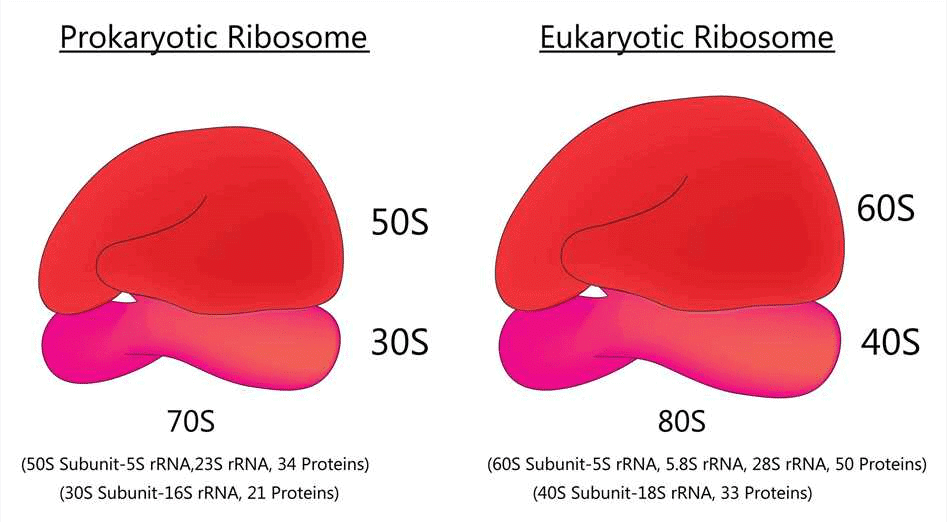
Cytoskeleton
An elaborate network of filamentous proteinaceous structures consisting of microtubules, microfilaments and intermediate filaments present in the cytoplasm is collectively referred to as the cytoskeleton.
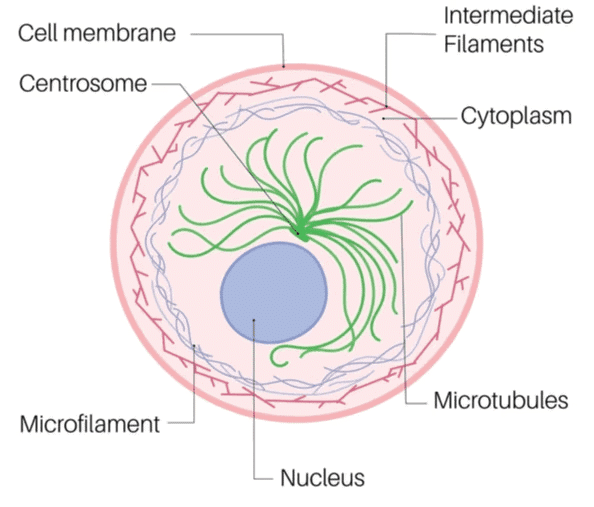
The cytoskeleton in a cell is involved in many functions such as:
- mechanical support
- motility
- maintenance of the shape of the cell.
The document Mitochondria, Plastid, Ribosome & Cytoskeleton | Biology Class 11 - NEET is a part of the NEET Course Biology Class 11.
All you need of NEET at this link: NEET
|
169 videos|524 docs|136 tests
|
FAQs on Mitochondria, Plastid, Ribosome & Cytoskeleton - Biology Class 11 - NEET
| 1. What is the function of mitochondria in a cell? |  |
Ans. Mitochondria are responsible for producing energy in the form of ATP through a process called cellular respiration. They are known as the powerhouse of the cell.
| 2. What are plastids and what are their roles in a cell? |  |
Ans. Plastids are double-membraned organelles found in plant cells. They have various functions including storing and synthesizing important molecules such as pigments, starch, and lipids. Chloroplasts, a type of plastid, are responsible for photosynthesis.
| 3. How do ribosomes contribute to cell function? |  |
Ans. Ribosomes are the cellular structures responsible for protein synthesis. They read the genetic information from mRNA and assemble amino acids in the correct order to form proteins. They play a crucial role in the growth and maintenance of the cell.
| 4. What is the cytoskeleton and what are its components? |  |
Ans. The cytoskeleton is a network of protein filaments that provides structural support and maintains cell shape. It is composed of three main components: microtubules, microfilaments, and intermediate filaments. These filaments also play a role in cell movement, intracellular transport, and cell division.
| 5. How are mitochondria, plastids, ribosomes, and the cytoskeleton interconnected in a cell? |  |
Ans. Mitochondria and plastids are both membrane-bound organelles involved in energy production and storage. Ribosomes, located in the cytoplasm or attached to the endoplasmic reticulum, synthesize proteins that are targeted to various organelles including mitochondria and plastids. The cytoskeleton provides the structural framework for all cellular components, including organelles, and also facilitates their movement within the cell. So, all these components work together to ensure the proper functioning of a cell.
Related Searches
















